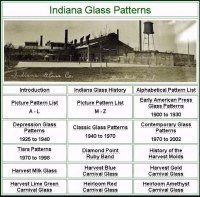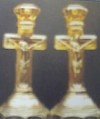1895 to 1922
It is hard to know where to begin when it comes to the history of the Indiana Glass Company. They have such an undocumented and "elusive" past. I know this site deals mainly with the 70's carnival glass but I thought it was important to include a history of the company so I am going to start at the beginning.
In 1895, the Pennsylvania Railroad Co. built a large building in Dunkirk, Indiana. It was named the Dunkirk Locomotive and Car Repair Works and the intended use was to build and repair railroad cars. This idea was soon abandoned and the building and property were purchased by George Brady and James Beatty in 1896. Together they formed the Beatty - Brady Glass Company. They produced glass lamps, glass chimney tops, vases and some household glass.
In the early 1900's, the Beatty - Brady Glass Co. merged into the National Glass Combine. National Glass was a large combine consisting of nineteen different glass companies. Competition was keen in the glass making business. These companies pooled their resources and their moulds in an effort to survive. The Beatty - Brady name was changed to the Indiana Glass Company. An Indiana inspection book, dated 1904, lists inspections as having been done at the “Indiana Glass Co., pressed and blown glass.” The Beatty - Brady company name is not listed.
In 1907 the National Glass Combine failed due to the depressed economy and several bank failures and was placed in receivership. The Indiana Glass Company was sold to a group consisting of Frank Merry, (President), Harry Batsch, Harold Phillips (Sec. - Treas.), Charles Smalley, Rathburn Fuller and James Merry Overleaf. A document dated Oct 11, 1907 stated, "Indiana Glass Co. , manufacturers of Pressed and Blown Glassware, Frank W. Merry, Pres; H. H. Phillips, Sec- Treas." Frank Merry remained President of the Indiana Glass Company until 1931.
The founding date of 1907 occurred when the plant was purchased and the company incorporated. The early company letterhead stated, “Est 1907".
The Indiana Glass Company was "officially born" in 1907.
The Indiana Glass Company made pressed and blown glassware. They made lamps and press molded decorative plates and bowls. Indiana Glass is believed to be the longest producer of "Goofus Glass".
For those of you that are not familiar with Goofus Glass, Goofus Glass was a VERY inexpensive way to make colored, decorative glass. Pressed, patterned glass items were "cold painted" (not fired) and the paint was not permanent. If used or washed, the paint soon flaked off. A bowl or plate was painted gold on the exterior and the pattern on the interior was filled in with paint. Red and gold seemed to be the standard colors and sometimes green.
It is believed that Northwood applied for a patent on Goofus Glass in 1903. Northwood and Dugan produced Goofus from about 1905 until 1908 . Westmoreland also made Goofus, mainly painted milk glass items and Imperial made a few rose patterns. When Fenton introduced carnival glass in 1907, Northwood, Dugan and Imperial soon followed Fenton's lead. While the other major glass makers were producing carnival glass, Indiana Glass continued to produce Goofus. Their Goofus glass production continued well into the 1920's.
The main buyers for Goofus Glass were businesses, not household consumers. Businesses bought the stuff by the barrels full. Buy a house, get a set of dishes, go to the movies, get a bowl, buy new furniture, get a plate, start a new account at the bank and get a vase! The general public may have thought it was goofy glass but businesses loved it and continued to give it away for many years.
Goofus Glass was America's "First Carnival Glass". It was given away at carnivals as prizes long before the pretty iridescent glass we know today as carnival glass. Carnivals were major buyers of Goofus glass.
Indiana Goofus Glass
|
||
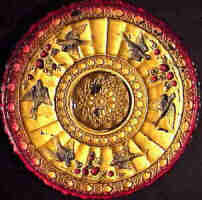 |
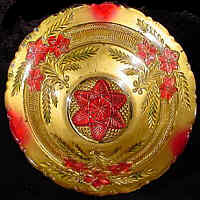 |
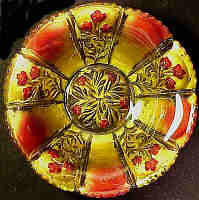 |
Bluebirds & Strawberries
|
Bouquet
|
Paneled Heather
|
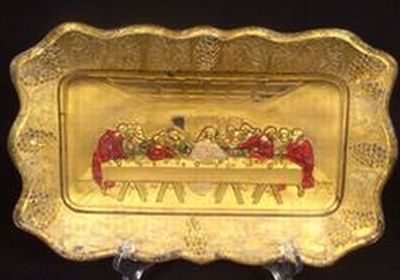 |
||
Lord's Supper Plate in Goofus
|
||
Lord's Supper Plates were reproduced by Indiana Glass and sold thru the Tiara Line (1970-1998). It was reproduced in the large 7 by 11 inch plate size and the mini tray size.
|
||
Indiana Glass did make a few carnival glass items but their production must have been very limited as there is so little of it available today. There are a few tumblers in the above Bird and Strawberry pattern. I have pictured one below. They are very rare. The Bird and Strawberry pattern was first introduced in about 1916. It was made in goofus, decorated and some carnival. The carnival tumblers may have been experimental.
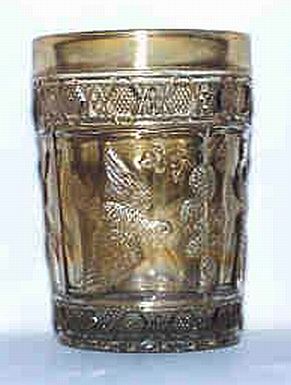 |
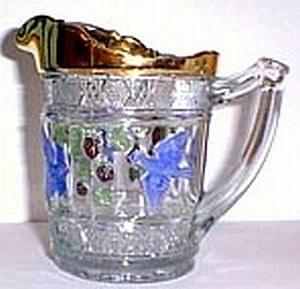 |
Bird & Strawberry Carnival Tumbler - 1916
|
Bird & Strawberry Decorated Creamer 1916
|
By 1914, Indiana Glass was manufacturing tableware, jellies, tumblers, goblets, lamps, stemware, bar goods, decorated tableware and novelties.
I have spoken with several retired Indiana Glass workers. The "bar goods" part of the above list included beer mugs, shot glasses and carnival glass ashtrays. According to the sources I spoke with, there was still a considerable surplus of carnival glass ashtrays stockpiled in the 60's and 70's. Some of these were bolted together and made into clocks. The bolted together carnival ashtrays were the housing for the clock mechanism.
The novelty items included such things as small glass telephones, trains, rocking chairs and other small furniture items. These were intended as play items for children and girls often used the small furniture items to decorate their doll houses. The novelty items were often advertised to shop owners and businesses as souvenir items. Many of these items were offered with an optional marigold carnival glass finish. The ads below are from a 1914 Butler Brother Wholesale Catalog.
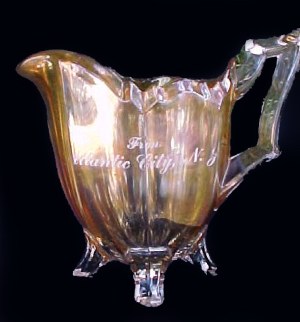 |
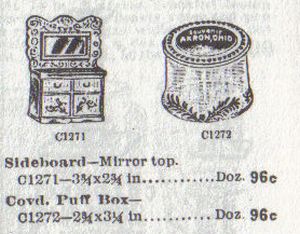 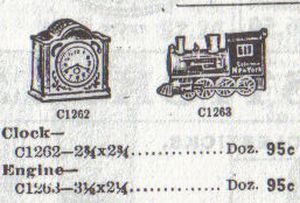 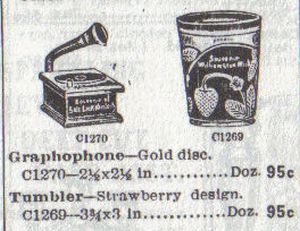 |
Marigold Carnival Glass Atlantic City Creamer in the Fluted Colonial or Quadruped pattern. These were offered in old Butler Brothers Wholesale Catalog ads. The carnival finish is rare.
|
|
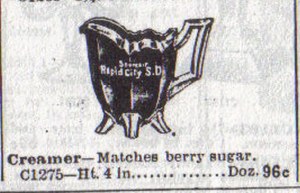 |
|
Click here to see the complete 1914 Buttler Brother Ad
|
|
Indiana Glass made beautiful water sets, tumblers and berry sets. These were pressed, geometric pattern glass much like Imperial's designs. They were made of crystal and decorated with gold trim and the pattern was accented with a red stain or flashing. Below are two of the early Indiana decorated patterns. These patterns are seldom see today.
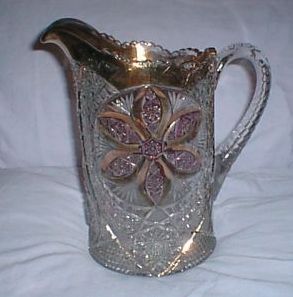 |
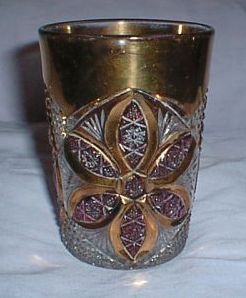 |
Indiana Ferris Wheel Pitcher - 1909
|
Indiana Ferris Wheel Tumbler
|
There is a carnival glass tumbler listed in the carnival glass books that greatly resembles the Indiana Ferris Wheel pattern. The tumbler is called Lucile and it is thought to have an Argentina maker. It has been suggested by the Thistlewoods that perhaps Indiana Glass sold the mold to the Argentina maker.
Please examine the pictures below. The tumblers look like the same pattern but they came from two totally different molds. The Argentina maker did not buy the Indiana mold, they stole the pattern.
|
|
 |
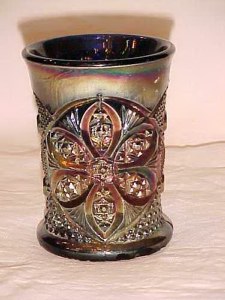 |
Indiana Ferris Wheel Tumbler
|
Lucile Carnival Tumbler
|
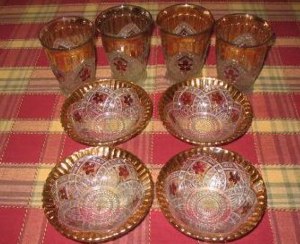 |
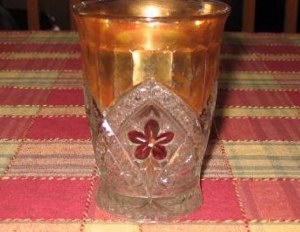 |
Flower Medallion Berry Bowls and Tumblers - 1916
|
Flower Medallion Tumbler
Please note the carnival trim.
|
The above berry bowls and tumblers were never reproduced.
|
|
 Rare Flower Medallion Pitcher from the Tiara Line.
|
The Flower Medallion pattern was reproduced by Indiana Glass and offered thru the Tiara Line. The pitcher, goblets, a small compote or wine and a swan were reissued in lime green carnival glass, no other colors. The reproductions were offered in very limited quantities. The Tiara Line was sold thru home parties. The Flower Medallion items were "Preferred Hostess" items, gifts that could be earned for exceptional sales. The Flower Medallion reissues are almost as rare as the early Flower Medallion items.
|
More Early Indiana Glass Patterns
|
|
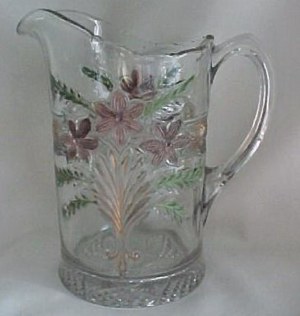 |
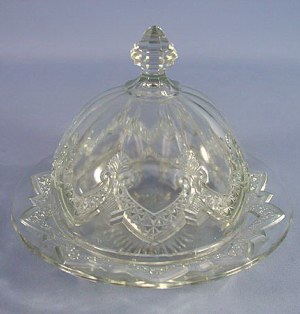 |
Narcissus Spray Pitcher - 1918
|
Gothic Windows - 1920
|
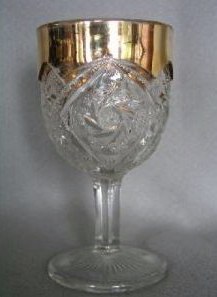 |
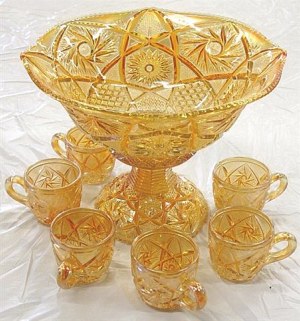 |
Whirling Star Wine
|
Whirling Star Punch Set
|
According to Carl Burns (carnival glass book author), in the early 1920's Indiana Glass made this rare Whirling Stars punch set. The punch bowl, punch bowl base and little cups are EXACTLY the same shape and size as the 1970's Heirloom punch sets.
Check the Indiana Patttern List for more early Indiana Glass Patterns
|
|
In 1919, Indiana Glass added more vases to their line. Their Goofus vases are highly collectible now and much loved among Goofus Glass collectors. Their "Fancy Decorated Lamps" are also highly prized among glass collectors.
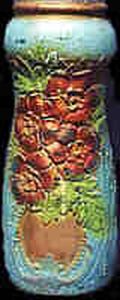 |
 |
Indiana #24
|
Indiana #14
Basketweave on Grape
|
Indiana Glass did not make it easy for anyone to trace their past. Another pattern that is believed to be made by the Indiana Glass Company is the Bird and Grape Pattern. This pattern was made in goofus vases, goofus wallpockets and carnival glass wall pockets as well.
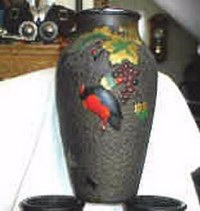 |
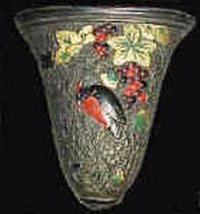 |
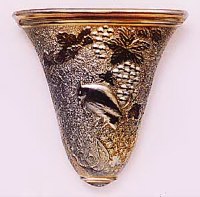 |
||
Bird on Grape Goofus Vase
|
Bird on Grape Wallpocket
|
Bird on Grape Carnival Wallpocket
|
||
Picture courtesy of
David Doty
|
In 1919, Indiana Glass also added soda fountain supplies to their line of glassware. Their soda fountain line included the now famous and very familiar A&W Root Beer Mugs. The first A&W Mug was Indiana Glass, #1504, a 10 ounce mug.
In 1921 the Baby A&W Root Beer Mug was added. It was Indiana, #1505, a 3 1/2 ounce mug. Indiana Glass continued to make the A&W Root Beer Mugs until about 1980.
That's about it for the very early years of Indiana Glass. If anyone has any documentation or other information on early Indiana Glass please email me and it will be included on this site.
Click on the link below if you would like to continue and learn about the Indiana Glass History from 1923 to 1950.
Search Our Sites
Our other sites you may enjoy:
Great Reference for Newer Carnival Glass.
Complete Glassware Catalogs Available to Download
Everything you EVER want to know about carnival glass and MORE!
Questions? Comments? Suggestions? Broken Links? Corrections?
Your Friendly Webmaster is here to help!
